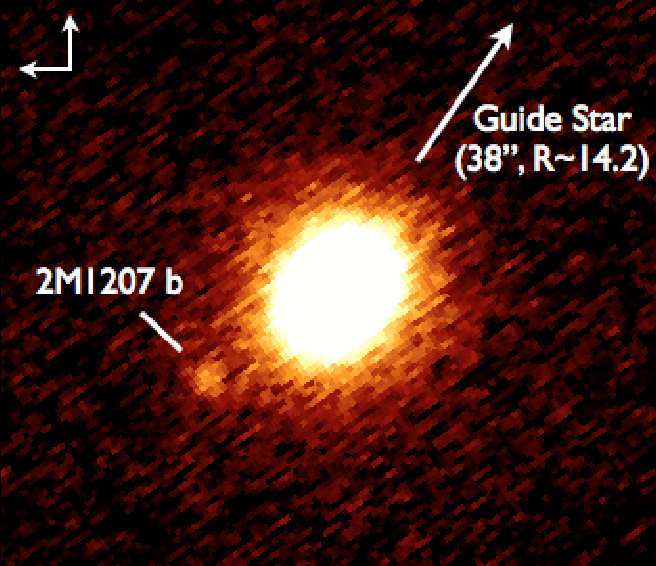2M1207 b (pronounced two-mass-twelve-oh-seven-bee) is often considered the first directly imaged extrasolar planet. Though its primary star, 2M1207 A, is actually a brown dwarf, b shares many properties with the HR 8799 planets. Andy Skemer analyzed images taken with MagAO+Clio2 and compared the results with images of the HR 8799 planets taken with the LBT. The interesting thing about 2M1207 b is that it doesn’t seem to have methane in its atmosphere — otherwise we wouldn’t have been able to see it since methane should absorb all the light at the wavelength we used.
Imaging 2M1207 b is extremely challenging from a technical standpoint. 2M1207 A is a faint brown dwarf, which doesn’t emit enough visible photons for our wavefront sensor. Instead, we locked on an off-axis (and still faint) star 40″ away from the science target. The result demonstrates that MagAO can produce reasonable Strehl ratio images on targets that are too faint to serve as their own guide-star.

Abstract: Gas-giant planets emit a large fraction of their light in the mid-infrared (≳3μm), where photometry and spectroscopy are critical to our understanding of the bulk properties of extrasolar planets. Of particular importance are the L and M-band atmospheric windows (3-5μm), which are the longest wavelengths currently accessible to ground-based, high-contrast imagers. We present binocular LBT AO images of the HR 8799 planetary system in six narrow-band filters from 3-4μm, and a Magellan AO image of the 2M1207 planetary system in a broader 3.3μm band. These systems encompass the five known exoplanets with luminosities consistent with L→T transition brown dwarfs. Our results show that the exoplanets are brighter and have shallower spectral slopes than equivalent temperature brown dwarfs in a wavelength range that contains the methane fundamental absorption feature. For 2M1207 b, we find that thick clouds and non-equilibrium chemistry caused by vertical mixing can explain the object’s appearance. For the HR 8799 planets, we find that the atmospheres must have patchy clouds, along with non-equilibrium chemistry. Together, the presence of a heterogeneous surface and vertical mixing presents a picture of dynamic planetary atmospheres in which both horizontal and vertical motions influence the chemical and condensate profiles.
You can download the pre-print at astro-ph.